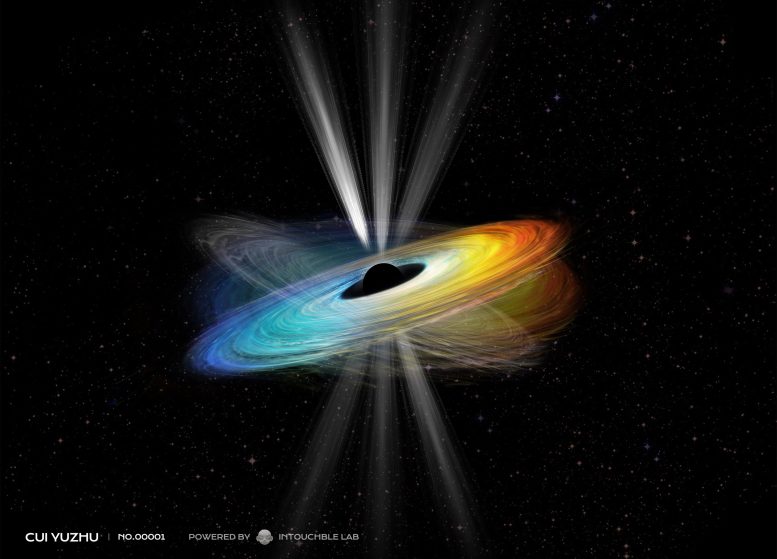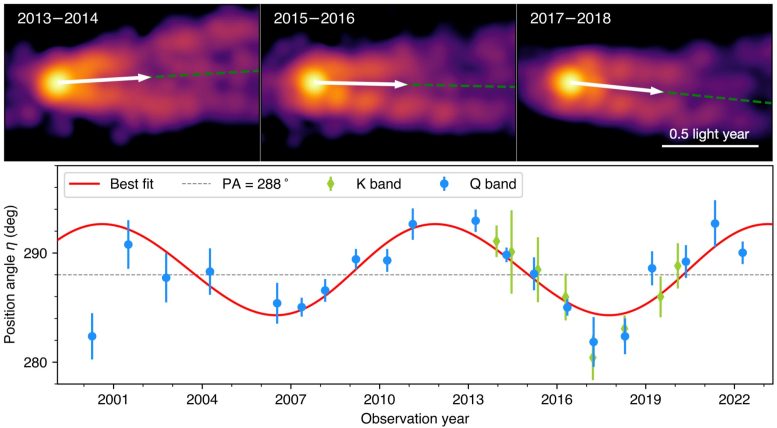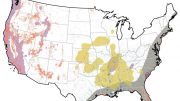
Schematic representation of the tilted accretion disk model. The black hole spin axis is assumed to be straight up and down in this illustration. The jet direction points almost perpendicular to the disk plane. The misalignment between the black hole spin axis and disk rotation axis triggers the precession of the disk and jet. Credit: Yuzhu Cui et al. (2023), Intouchable Lab@Openverse and Zhejiang Lab
Researchers confirm the spin of the M87 galaxy’s supermassive black hole by observing the wobble in its jet, using two decades of data from global radio telescopes. This discovery marks a significant advancement in black hole studies.
The supermassive black hole at the heart of galaxy M87, made famous by the first picture of a black hole shadow, has yielded another first: the jet shooting out from the black hole has been confirmed to wobble, providing direct proof that the black hole is spinning.
Supermassive black holes, monsters up to billions of times heavier than the Sun that eat everything around them including light, are difficult to study because no information can escape from within. Theoretically, there are very few properties that we can even hope to measure. One property that might possibly be observed is spin, but due to the difficulties involved, there have been no direct observations of black hole spin.
Two Decades of Observations Yield Evidence
Searching for evidence for black hole spin, an international team analyzed over two decades of observational data for the galaxy M87. This galaxy located 55 million light-years away in the direction of the constellation Virgo harbors a black hole 6.5 billion times more massive than the Sun, the same black hole that yielded the first image of a black hole shadow by the Event Horizon Telescope (EHT) in 2019. The supermassive black hole in M87 is known to have an accretion disk, which feeds matter into the black hole, and a jet, in which matter is ejected from near the black hole at close to the speed of light.

(Top panel) M87 jet structure at 43 GHz averaged over every two years from 2013 to 2018. The corresponding years are indicated in the left-top corner. The white arrows indicate the jet position angle in each subplot. (Bottom panel) Observed evolution of jet direction between 2000 and 2022. The green and blue points are obtained from observations at 22 and 43 GHz. The red line represents a best-fit sinusoidal curve with a period of 11 years. Credit: Yuzhu Cui et al. (2023)
The team analyzed data for 170 time frames collected by the East Asian VLBI Network (EAVN), the Very Long Baseline Array (VLBA), the joint array of KVN and VERA (KaVA), and the East Asia to Italy Nearly Global (EATING) VLBI network. In total, more than 20 radio telescopes across the globe contributed to this study.
Findings and Implications
The results show that gravitational interactions between the accretion disk and the black hole’s spin cause the base of the jet to wobble, or precess, much the same way that gravitational interactions within the Solar System cause the Earth to precess. The team successfully linked the dynamics of the jet with the central supermassive black hole, providing direct evidence that the black hole does in fact spin. The jet’s direction changes by about 10 degrees with a precession period of 11 years, matching theoretical supercomputer simulations conducted by ATERUI II at the National Astronomical Observatory of Japan (NAOJ).
“We are thrilled by this significant finding,” says Yuzhu Cui, lead author on the paper summarizing the research she started as a graduate student at NAOJ before moving to Zhejiang Lab as a postdoctoral researcher. “Since the misalignment between the black hole and the disk is relatively small and the precession period is around 11 years, accumulating high-resolution data tracing M87 structure over two decades and thorough analysis are essential to obtain this achievement.”
“After the success of black hole imaging in this galaxy with the EHT, whether this black hole is spinning or not has been a central concern among scientists,” explains Dr. Kazuhiro Hada from NAOJ. “Now anticipation has turned into certainty. This monster black hole is indeed spinning.”
“This is an exciting scientific milestone that was finally revealed through years of joint observations by the international researchers team from 45 institutions around the world, working together as one,” says Dr. Motoki Kino at Kogakuin University, the coordinator of the East Asian VLBI Network Active Galactic Nuclei Science Working Group. “Our observational data beautifully fitted to the simple sinusoidal curve bring us new advances in our understanding of black hole and jet system.”
For more on this discovery, see Supermassive Black Hole’s Spin Verified.
Reference: “Precessing jet nozzle connecting to a spinning black hole in M87” by Yuzhu Cui, Kazuhiro Hada, Tomohisa Kawashima, Motoki Kino, Weikang Lin, Yosuke Mizuno, Hyunwook Ro, Mareki Honma, Kunwoo Yi, Jintao Yu, Jongho Park, Wu Jiang, Zhiqiang Shen, Evgeniya Kravchenko, Juan-Carlos Algaba, Xiaopeng Cheng, Ilje Cho, Gabriele Giovannini, Marcello Giroletti, Taehyun Jung, Ru-Sen Lu, Kotaro Niinuma, Junghwan Oh, Ken Ohsuga, Satoko Sawada-Satoh, Bong Won Sohn, Hiroyuki R. Takahashi, Mieko Takamura, Fumie Tazaki, Sascha Trippe, Kiyoaki Wajima, Kazunori Akiyama, Tao An, Keiichi Asada, Salvatore Buttaccio, Do-Young Byun, Lang Cui, Yoshiaki Hagiwara, Tomoya Hirota, Jeffrey Hodgson, Noriyuki Kawaguchi, Jae-Young Kim, Sang-Sung Lee, Jee Won Lee, Jeong Ae Lee, Giuseppe Maccaferri, Andrea Melis, Alexey Melnikov, Carlo Migoni, Se-Jin Oh, Koichiro Sugiyama, Xuezheng Wang, Yingkang Zhang, Zhong Chen, Ju-Yeon Hwang, Dong-Kyu Jung, Hyo-Ryoung Kim, Jeong-Sook Kim, Hideyuki Kobayashi, Bin Li, Guanghui Li, Xiaofei Li, Zhiyong Liu, Qinghui Liu, Xiang Liu, Chung-Sik Oh, Tomoaki Oyama, Duk-Gyoo Roh, Jinqing Wang, Na Wang, Shiqiang Wang, Bo Xia, Hao Yan, Jae-Hwan Yeom, Yoshinori Yonekura, Jianping Yuan, Hua Zhang, Rongbing Zhao and Weiye Zhong, 27 September 2023, Nature.
DOI: 10.1038/s41586-023-06479-6









“Black Holes Might Not Be Quite as ‘Simple’ as We Thought, New Paper Suggests” – Oct. 5, 2023
Mentions two black holes spinning in opposite directions. Matches the rattlesnake-tail pattern I’m seeing here.
The paper reviewed is “Static Black Binaries in de Sitter Space” – Óscar J. C. Dias, Gary W. Gibbons, Jorge E. Santos, and Benson Way; Phys. Rev. Lett. 131, 131401 – Published 25 September 2023.
As I compared the apparent landscape to a shallow dish of battle-tops, beneath a previous incarnation of this topic, and as I’m not a fan of de Sitter space for convenient gravity lensing suppositions, believing anti de Sitter space is the kind of lightspeed-aliasing model that nonsingular conformal gravity approaches can best support, the title admirably puts emphasis on the crux and on the dark energy “cope,” as the kids apparently like to say. I mean what else could they be looking at but this binary? Not throwing any shade, just saying.
If space and time are not curved, then the more gravitationally red-shifted that a glowing orbiting object becomes in strong gravity, the faster (not slower) its orbit becomes. Accordingly, gravitational redshift is a distortion of photons through lightspeed variation, not a distortion of time, no motion is slowed in gravitational redshift, in other words gravitational time dilation is a presumption based on stretched photons and a misplaced belief in lightspeed that isn’t affected by gravity. The event horizon is a condition where a potentially glowing object’s orbit approaches a gravitationally-increased light speed.
Expansion and Doppler redshift is a rate-slowing type of distortion of information flow rate aliasing as a slowing distortion of time rate.
If the wobble of M87 were the same effect of the milky way black hole and on the 11yr cycle be the catalyst of our suns 11yr cycle of high radiation activity
The last computerized enhancement suggested regions of the accretion ring may carry a twist or knot that could carry rotational flows distinctly different from the ring as a whole, with a distinctly different rotational axis.
It seems much easier to understand this structure as a product of multiple focused gravitational spin information flows focused on different external objects. A number of supernovae are said to be in the path of the beam. It may also line up with another galaxy, but I could be wrong. Hard for me to imagine there is no dark matter filament spin gravity effect going on between these masses.